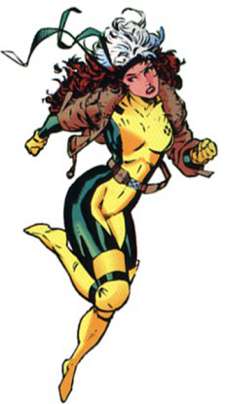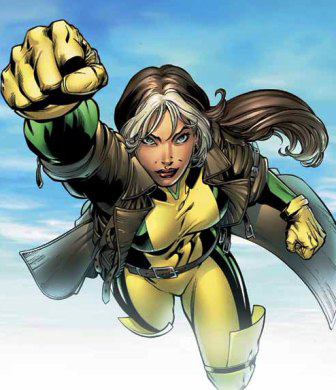This first appeared on Comixology.
__________________
 Superheroes are power fantasies. This is not in dispute.
Superheroes are power fantasies. This is not in dispute.
The latest testament to this truth was provided to me by U Mass Lowell professor Susan Kirtley, one of the contributors to Craig Fischer’s Team Cul de Sac zine to benefit Parkinson’s research. The zine consists of a number of critics (including me!) discussing their favorite comics.
Kirtley’s piece starts by talking about one day in elementary school when she found an acquaintance, Sean Robinson, “huddled against the brick wall of the school.” Sean huddled over a piece of reading material “which was bright and colorful and quite possibly naughty.” Kirtley demanded to know what he was reading, at which point Sean declared, “‘girls don’t read comic books.'”
Thus encouraged, Kirtley headed over to the “spindly wire rack” the next time she was at the grocery store, got her mom to purchase some X-Men comics…and fell in love. She was especially taken with Rogue…and here’s where the power fantasy comes in. As Kirtley says:
As I began to read the exploits of Cyclops and the team I realized these were kindred spirits. Was I not like the tortured blue Beast, a genius hiding away from the world, unappreciated and misunderstood. I certainly longed to fry some of my classmates (including Sean Robinson) with laser beams that shot out of my eyes. But most of all I adored Rogue, the Southern belle with the green and yellow uniform and unflattering skunk-striped hair, who embodied all my tweenage anxiety…. Unable to touch others without harming them, Rogue was tragic and beautiful. I, with no desire to touch others, thought myself tragic and wished to be beautiful. When I pulled the X-Men comic off the rack at Safeway I did so out of spite, but as a lonely, awkward girl I found something in comics — excitement and adventure, of course, also hope that like Rogue, I could transcend the past and become something more, despite my flaws and a horrible haircut.
Kirtley saw herself in Rogue — not the self she was, but the self she could be, a self that could “transcend the past.”
Kirtley’s description of anticipating her future self through the image of Rogue finds an echo in the work of psychoanalytic theorist Jacques Lacan. In his 1949 essay “The Mirror Stage as Formative of the Function of the I as Revealed in the Psychoanalytic Experience,” Lacan discussed the mirror stage: the moment when the child first recognizes itself in the mirror.
This event [the child seeing itself in the mirror] can take place…from the age of six months, and its repetition has often made me reflect upon the startling spectacle of the infant in front of the mirror. Unable as yet to walk, or even to stand up, and held tightly as he is by some support human or artificial…he nevertheless overcomes, in a flutter of jubilant activity, the obstructions of his support, and, fixing his attitude in a slightly leaning-forward position, in order to hold it in his gaze, brings back an instantaneous aspect of the image. [translation by Alan Seridan]
Just as Kirtley sees Rogue and is joyous, so the child sees its future self and is “jubilant”. The mirror stage, the power fantasy, is tied to happiness.
Lacan says that “the important point is that this form situates the agency of the ego, before its social determination, in a fictional direction.” And he adds that, looking in the mirror, the child “anticipates in a mirage the maturation of his power.” In other words, the child looking in the mirror is not seeing and recognizing a real self. Rather, she is misrecognizing a fictional self — an anticipatory self. This false self is integrated, functional, whole — a self that is not yet but will eventually reach a “maturation of…power.” Thus, Lacan’s child is happily seeing in the mirror exactly what Kirtley happily sees when she looks at Rogue in the comic; a false future self.
For Lacan, then, every self is always already a power fantasy — every self is a fictional superself. The lonely, awkward Kirtley is as much a misrecognized image as Rogue. Indeed, Sean Robinson sitting on the ground with his comic and his sneering can himself be seen as a super-mirror-image; an anticipation by Kirtley of Kirtley. The main superpower we want, the superpower we are constantly pretending to have, is self itself; a coherent being. As Lacan says, the Gestalt, or spontaneous formation of the image, unites the I, or ego or self
with the statue in which man projects himself, with the phantoms that dominate him, or with the automaton in which, in an ambiguous relation, the world of his own making tends to find completion.
Indeed…the mirror-image would seem to be the threshold of the visible world.
Lacan is saying that the fictional self, or selves, is (or are) a trap. The images of your self you make turn you into a congealed statue, place you at the mercy of ghosts, turn your world into an automaton which grinds you up. Kirtley is Sean, is the awkward girl, is Rogue, and all these false self-images hold and haunt her.
But, at the same time, Lacan suggests, it is these images which allow, or open, the world. He uses the example of pigeons, which (he claims) can’t attain sexual maturity in isolation. An isolated pigeon will not mature normally — unless you show it its own image in a mirror. Fooled into thinking its self is another, it will grow gonads, and become the fully functional pigeon it was meant to be.
Similarly, the future, dreamed-of human self is not a real self, and is in some ways a dangerous myth…but still, without the power fantasy, where are you? Child-Kirtley would not become Rogue, of course. But without the dream of transcending a false self through a false self, she would have had no false self, which is the only self. Misrecognition is the only recognition; the only thing the child sees is the mirror.
If the child sees only a mirror, then what about Lacan? Surely the images of self he sees are also misrecognitions? Or, to put it another way, if the self is always false, then the self declaring that the self is always false is also a power fantasy. Lacan seems to acknowledge as much in this oddly worded sentence:
This event [the child seeing itself in the mirror] can take place…from the age of six months, and its repetition has often made me reflect upon the startling spectacle of the infant in front of the mirror.
Lacan says he has been made to “reflect” upon the spectacle of the infant in front of the mirror. Lacan, then, is reflecting on, or looking at the infant just as the infant looks at its own reflection. The mirror stage is itself an image; a vision of the self. Lacan’s integrated self, his superpower, is the image of a self split in two. His misrecognized self, which (joyfully?) startles him, is a misrecognized self.
I think you can see this reflected in Kirtley’s essay too. The “I” in Kirtley’s piece, the older-Kirtley, looks at her younger I misrecognizing a super-I that anticipates, but is not, the older-I. Kirtley looks into the past to see a split self, a divided not-her that provokes jubilation. Similarly, I think, what I get from reflecting on the essay is a look at myself looking at older-Kirtley looking at younger-Kirtley looking at Rogue, those beguiling images within images, the super-power that is the me I can’t touch.


